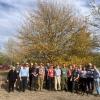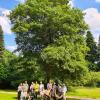Editor's Picks
Plant Focus
Sustaining Oaks in the Chicago Region Landscape: Developing a Plan for Maintaining Oak Dominance in an Urban Landscape
Lindsay Darling and Robert T. Fahey
Published May 2016 International Oaks No. 27: 195–206
Abstract
Oaks have historically been the dominant tree species in the Chicago region, and are keystones in the region’s ecosystems. However, following Euro-American settlement and subsequent urbanization their dominance has declined across the region. Development has destroyed many of the original oak ecosystems, and those that remain are fragmented and under threat from mesophication and invasive species introductions. Oak regeneration is uncommon in many of the region’s natural areas and oaks are underrepresented in urban forests relative to their dominance in the region’s natural ecosystems. The need for a unified strategy for oak management has been apparent to land managers in the region, but crafting such a strategy presents difficulties in a large, highly urbanized metropolitan area such as the greater Chicago region. Developing a successful strategy for maintaining and enhancing oak dominance in such an area requires the inclusion and participation of a wide range of land use types and an equally wide array of stakeholder groups. This paper outlines how a regional strategy for maintaining oak dominance in the Chicago region was developed by the Chicago Wilderness Oak Recovery Working Group.
Keywords
oak ecosystem decline, oak conservation, urban trees
References
Abrams, M.D. 1992. Fire and the Development of Oak Forests. BioScience 42: 346-353.
Abrams, M.D. 2003. Where has all the white oak gone? Bioscience 53: 927-939.
Bowles, M., M. Hutchison, and J. McBride. 1994. Landscape pattern and structure of oak savanna, woodland, and barrens in northeastern Illinois at the time of European settlement. Proceedings of the North American Conference on Savannas and Barrens: 65-73.
Bowles, M., M. Jones, J. McBride, T. Bell, and C. Dunn. 2005. Temporal instability in Chicago’s upland old growth forests. Chicago Wilderness Journal 3: 5-16.
Carter, D.R., R.T. Fahey, K. Dreisilker, M.B. Bialecki, and M.L. Bowles. 2015. Assessing patterns of oak regeneration and C storage in relation to restoration-focused management, historical land use, and potential trade-offs. Forest Ecology and Management 343: 53-62.
Chicago Wilderness. 1999. Biodiversity recovery plan. Chicago Wilderness. URL: http://www.chicagowilderness.org/?page=publicationsnew
Dey, D.C., A.A. Royo, P.H. Brose, T.F. Hutchinson, M.A. Spetich, and S.H. Stoleson. 2010. An ecologically based approach to oak silviculture: a synthesis of 50 years of oak ecosystem research in North America. Revista Colombia Forestal 13: 2.
Fahey, R.T., M.L. Bowles, and J.L. McBride. 2012. Origins of the Chicago urban forest: composition and structure in relation to pre-settlement vegetation and modern land-use. Arboriculture & Urban Forestry 38: 181-193.
Fahey, R., D. Maurer, M. Bowles, and J. McBride. 2014. Evaluating restoration baselines for historically fire-protected woodlands within a Northeastern Illinois Prairie Peninsula landscape. Natural Areas Journal 34: 166-177.
Fahey, R.T., L. Darling and J. Anderson. 2016. Chicago Wilderness Oak Ecosystems Recovery Plan: Sustaining Oaks in the Chicago Wilderness Region. URL: http://www.chicagowilderness.org/?page=publicationsnew
Kromroy, K., K. Ward, P. Castillo, and J. Juzwik. 2007. Relationships between urbanization and the oak resource of the Minneapolis/St. Paul Metropolitan area from 1991 to 1998. Landscape and urban planning 80: 375-385.
Lesser, W.H. 1993. Prehistoric human settlement in the upland forest region. In: Upland forests of West Virginia, (ed.) Stepheson, S.L. West Virginia: McClain Printing Company.
Lorimer, C.G. 1993. Causes of the oak regeneration problem. Oak Regeneration: Serious Problems, Practical Recommendations, USDA Forest Service General Technical Report SE-84, Southeastern Forest Experiment Station, Asheville, North Carolina:14-39.
MacCleery, D.W. 1992. American forests: a history of resiliency and recovery. Pennsylvania: Diane Publishing Co.
McShea, W.J., and W.M. Healy. 2002. Oak forest ecosystems: ecology and management for wildlife. Baltimore: Johns Hopkins University Press.
Nowacki, G.J., and M.D. Abrams. 2008. The Demise of Fire and “Mesophication” of Forests in the Eastern United States. BioScience 58: 123.
Rodewald, A., and M. Abrams. 2002. Floristics and avian community structure: implications for regional changes in eastern forest composition. Forest Science 48: 267-272.
Tallamy, D.W. 2007. Bringing nature home. Portland: Timber Press.















